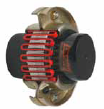The following info is critical when building a Grid coupling assortment:
Description of motor or engine, the horse energy (or KW), and RPM at slowest coupling pace while under load
Description on the driven tools
Shaft and keyway sizes as well as the type of match for driver and driven products (clearance or interference)**
Shaft separation (BSE)
Bodily space limitations (see Application Worksheet)
Ascertain what the environmental disorders will be, such as temperature, corrosive disorders, interference from surrounding structures, and so forth.
By default,  sizes 1020 – 1090 will be clearance match, sizes 1100 – 1200 will be interference match.
sizes 1020 – 1090 will be clearance match, sizes 1100 – 1200 will be interference match.
** Machines all bores and keyways to meet the dimensional and tolerance specifications per ANSI/AGMA 9002-B04 for inch bores, or ISO 286-2 for metric bores.
Normal grid couplings consist of two grid hubs, a grid spring, as well as a cover assembly. When the shaft separation necessitates a spacer fashion coupling, the coupling will consist of two shaft hubs, two spacer hubs, a grid spring, in addition to a horizontal cover assembly.
Formulas Utilized To Calculate Torque:
Application Torque (in-lbs) = ( horse power x 63025 ) /RPM
Application Torque (Nm) = ( horse power x 9550 ) /RPM
Assortment Torque = Application Torque x Support Aspect
Higher Peak Loads and Brake Applications
For applications the place higher peak loads or large braking torques may be existing, the following extra information will be vital:
Method peak torque and frequency
Duty cycle
Brake torque rating
The selection torque formula is much like the formula shown over except the application torque must be doubled just before applying the service factor.
Application Torque (in-lbs) = ( horse energy x 63025 ) /RPM
Application Torque (Nm) = ( horse energy x 9550 ) /RPM
Assortment Torque = 2 x Application Torque x Support Element
Techniques In Choosing A Grid Coupling
Stage one: Identify the application torque working with the formula shown above.
Step 2: Choose the Service Component from the charts .
For applications not displayed utilize the chart shown to your correct. Figure out the Choice Torque utilizing the formula proven above.
Phase three: Making use of the selection torque as calculated, refer for the Efficiency Chart
Step four: Assess the maximum bore for your size picked and make certain the expected bore sizes do not exceed the maximum allowable. Should the needed bore size is larger, stage up to the next size coupling and examine to view should the bore sizes will fit.
Phase five: Applying the selected coupling size, examine the bore and keyway sizes
Phase six: Contact your nearby industrial supplier with the portion numbers to place sizes using the charts for UPC portion numbers.
